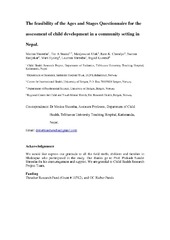The feasibility of the Ages and Stages Questionnaire for the assessment of child development in a community setting in Nepal
Shrestha, Merina; Strand, Tor A; Ulak, Manjeswori; Chandyo, Ram K.; Ranjitkar, Suman; Hysing, Mari; Shrestha, Laxman P.; Kvestad, Ingrid
Peer reviewed, Journal article
Accepted version
Permanent lenke
https://hdl.handle.net/1956/21957Utgivelsesdato
2019Metadata
Vis full innførselSamlinger
Originalversjon
https://doi.org/10.1111/cch.12654Sammendrag
Background: The Ages and Stages Questionnaire Third Edition (ASQ‐3) may be a feasible and cost‐effective tool to screen children's development in resource poor settings. We have assessed the feasibility of the ASQ‐3 “home procedure” when conducted by fieldworkers in a community‐based nutritional interventional trial on early child development in Nepal. Method: Six hundred children aged 6–11 months at risk of stunting were assessed by trained fieldworkers in their homes by the ASQ‐3. Three fieldworkers performed standardization exercises and were double scored with a gold standard during the study period. Intraclass correlations (ICCs) were calculated to measure the interrater agreement. The internal consistency was expressed by standardized Cronbach's alphas. The association between total ASQ score and gestation, low birth weight, and stunted children is presented to give an estimate of the construct validity of the tool. Result: Mean scores of the 600 Nepalese children were consistently lower than in the American norm sample. The ICCs from the standardization exercises were initially good to excellent but declined throughout the study period. The standardized alphas for the total score in the different age groups indicate good internal consistency but varied in the subscales. Children who were preterm, children with low birth weight, and children who were stunted scored substantially lower on the total ASQ score than those who were not. Conclusion: Although the ASQ‐3 “home procedure” is low at cost and easily accessible in a Nepalese context, the tool requires rigorous and stringent training to achieve acceptable interrater agreement. Further adjustment is required to achieve satisfactory internal consistency.
